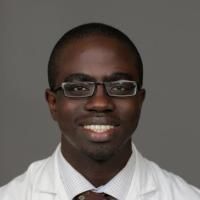Pulmonary blastomycosis presenting as primary lung cancer.
Date
2018-07-18
Journal Title
Journal ISSN
Volume Title
Repository Usage Stats
views
downloads
Citation Stats
Attention Stats
Abstract
BACKGROUND:Blastomycosis is an endemic mycosis in North America that is caused by the dimorphic fungus Blastomyces dermatitidis. The illness is a systemic disease with a wide variety of pulmonary and extra-pulmonary manifestations. The initial presentation of blastomycosis may easily be mistaken for other infectious or non-infectious etiologies. CASE PRESENTATION:We present the case of a 52-year-old African-American male and former smoker that presented to his primary care provider with a 2-week history of non-productive cough, night sweats and weight loss. Initially diagnosed with primary lung malignancy, the patient was subsequently found to have pulmonary blastomycosis mimicking lung cancer. The patient underwent a successful course of treatment with posaconazole. CONCLUSIONS:Chronic blastomycosis can present with clinical and radiographic features indistinguishable from thoracic malignancies. There is no clinical syndrome specific for blastomycosis, thus a high degree of suspicion is required for early diagnosis. In this case report, we review recent evidence in radiographic features, diagnostic considerations and treatment of the disease.
Type
Department
Description
Provenance
Subjects
Citation
Permalink
Published Version (Please cite this version)
Publication Info
Hussaini, Syed Mohammed Qasim, Deng Madut, Betty C Tong, Elizabeth N Pavlisko, Wiley A Schell, John R Perfect and Nathan M Thielman (2018). Pulmonary blastomycosis presenting as primary lung cancer. BMC infectious diseases, 18(1). p. 336. 10.1186/s12879-018-3244-0 Retrieved from https://hdl.handle.net/10161/18966.
This is constructed from limited available data and may be imprecise. To cite this article, please review & use the official citation provided by the journal.
Collections
Scholars@Duke

Deng Madut
I am an infectious diseases doctor who specializes in the care of patients with general infectious diseases, including persons living with HIV. My research is focused on improving the diagnosis and treatment of infectious diseases among populations living in low-resource settings.

Betty Caroline Tong

Elizabeth N Pavlisko
Dr. Pavlisko holds an undergraduate degree in Biochemistry from Clemson University and received her Doctor of Medicine from the Medical University of South Carolina. She completed her residency and is board certified in both Anatomic and Clinical Pathology. She trained as a pulmonary/thoracic pathology fellow at Duke University Medical Center under the mentorship of Drs. Victor Roggli and Thomas Sporn, two of the world’s leading Pulmonary Pathologist with expertise in pneumoconiosis and mesothelioma. She joined the faculty at Duke in 2011 as an Assistant Professor of Pathology, and her work is focused in thoracic, cardiovascular and transplant pathology as well as postmortem examination. Since starting her independent position, Dr. Pavlisko has developed expertise in neoplastic and non-neoplastic diseases of the lung and mediastinum with a special interest in lung transplantation and diseases of the pleura for which she is widely recognized as an authority. She currently serves as Chief of the Pulmonary/Thoracic Pathology Section.
Dr. Pavlisko’s clinical activities encompass pulmonary/thoracic and cardiovascular pathology, including transplantation, biomarker testing and autopsy pathology. Her primary research focus has centered on malignant mesothelioma and chronic lung allograft dysfunction (CLAD). She has published over 65 manuscripts and has 6 book chapters, the latter all centered on occupational diseases of the lungs and pleura. Since 2017, Dr. Pavlisko has co-chaired the lung steering committee for the Banff Foundation for Allograft Pathology. She is also an active member of the International Society for Heart and Lung Transplantation. Dr. Pavlisko has collaborations with the Departments of Pulmonary, Allergy and Critical Care Medicine and Cardiothoracic Surgery.
In addition to her clinical and research activities, Dr. Pavlisko is active in Duke University Hospital’s Clinical Laboratories and currently serves as the Medical Director of the Division of Anatomic Pathology and Digital Analytics (DAPDA) Laboratory, which includes Histology, Immunohistochemistry, FISH, and Image Analysis.

Wiley Alexander Schell

John Robert Perfect
Research in my laboratory focuses around several aspects of medical mycology. We are investigating antifungal agents (new and old) in animal models of candida and cryptococcal infections. We have examined clinical correlation of in vitro antifungal susceptibility testing and with in vivo outcome. Our basic science project examines the molecular pathogenesis of cryptococcal infections. We have developed a molecular foundation for C. neoformans, including transformation systems, gene disruptions, differential gene expression screens, and cloning pathogenesis genes. The goal of this work is to use C. neoformans as a model yeast system to identify molecular targets for antifungal drug development. There are a series of clinical trials in fungal infections which are being coordinated through this laboratory and my work also includes a series of antibiotic trials in various aspects of infections. Finally, we have now been awarded a NIH sponsored Mycology Unit for 5 years with 6 senior investigators which is focused on C. neoformans as a pathogenic model system, but will include multiple areas of medical mycology from diagnosis to treatment.

Nathan Maclyn Thielman
Broadly, my research focuses on a range of clinical and social issues that affect persons living with or at risk for HIV infection in resource-poor settings. In Tanzania, our group is applying novel methods to optimize HIV testing uptake among high-risk groups. We recently demonstrated that the Discrete Choice Experiment (DCE), a form of stated preference survey research, is a robust tool for identifying (a) which characteristics of HIV testing options are most preferred by different populations and (b) which tradeoffs individuals make in evaluating testing options. Building on more than a decade of productive HIV testing research in the Kilimanjaro Region, the next phase of our NIMH funded project will test the hypothesis that DCE-derived HIV testing options significantly increases rates of testing among groups at high risk for HIV infection. This work holds promise not only for optimizing HIV testing uptake in the Kilimanjaro Region, but also for applying novel tools in the service of translational epidemiology and implementation research.
Unless otherwise indicated, scholarly articles published by Duke faculty members are made available here with a CC-BY-NC (Creative Commons Attribution Non-Commercial) license, as enabled by the Duke Open Access Policy. If you wish to use the materials in ways not already permitted under CC-BY-NC, please consult the copyright owner. Other materials are made available here through the author’s grant of a non-exclusive license to make their work openly accessible.
